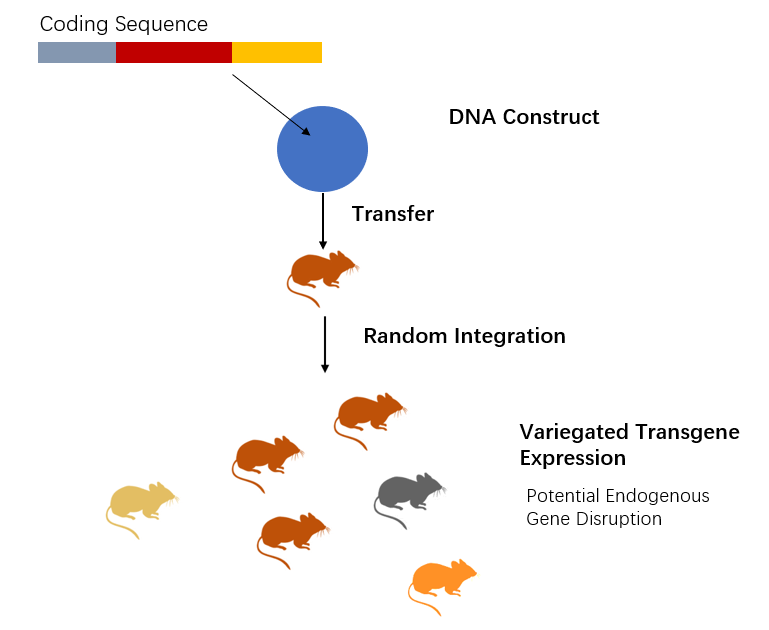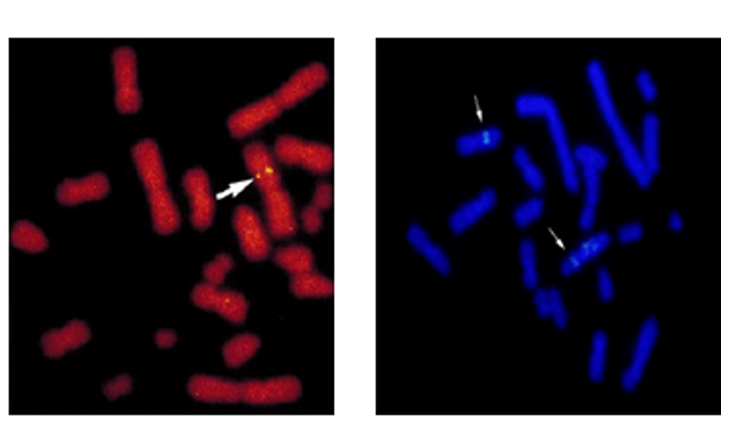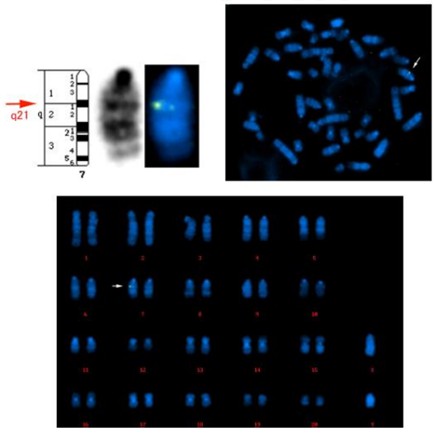Transgene Mapping (FISH)
- Overview
- Features
- Project Timeline
- Case Studies
- FAQs
For transgenic cell lines and transgenic animals generated via many methods, the integration site is random and in most cases not known. Integration of a transgene can disrupt an endogenous gene, potentially interfering with interpretation of the phenotype. In addition, knowledge of where the transgene is integrated is important for planning of crosses between animals carrying a conditional allele and a given Cre allele in case the alleles are on the same chromosome. When the transgene insertion site is unknown, zygosity is determined by expensive quantitative PCR-based approach. These limitations often force investigators to maintain transgenic models or cell lines in a hemizygous state, which may lead to less than desired expression levels of the transgene and make it less efficient and more costly. Fluorescence in situ hybridization (FISH) is a powerful technique that can be used to visualize transgene integration sites and provide a better understanding of transgene behavior.
With many years of experience and in-depth knowledge, Creative Bioarray can use fluorescence in situ hybridization (FISH) to confirm the integration of transgenes and determine their chromosome band location. We guarantee the speed, quality and cost of our service.
Benefits of Characterizing A Transgene Insertion Site
- Better correlation of phenotypes with transgene expression
- Ability to determine zygosity by genotyping assay and more cost effective management of transgenic strains
- Enhanced predictability of transgene segregation when breeding and intercrossing
- Awareness of any potential disruption of the regulatory or coding region of a critical endogenous gene
 Figure 1. Transgene integration is random.
Figure 1. Transgene integration is random.
 Figure 2. FISH detection of
transgene using plasmid probes on metaphase chromosome.
Figure 2. FISH detection of
transgene using plasmid probes on metaphase chromosome.
Features of Creative Bioarray's Transgene Mapping Service
- cDNA (2kb~) or genomic DNA fragment on banded chromosomes
- Species: human, mouse, rat, hamster, chicken
- Confirm the integration of transgenes
- Visualize chromosome band location
Deliverable
- Full scope support service-from sample preparation through to the final report
- Detailed report of insertion and transgene position
- Expert interpretation specific to a new transgenic line
Project Timeline

Case Studies
Transgene Mapping analysis of rat cell samples
Objective
Perform DNA FISH to confirm the integration of the transgene XXX and determine its chromosome band location in rat cell samples.
Results
Table 1: Study Sample:
| Samples | Qty |
| Rat Spleen Cells | 2 vials (5 x10^5 cells/vial) |
| Transgene XXX Plasmid | 1 vial |
The transgene was located on the q21 region of the chromosome 7.
 Figure 3. FISH
detection of transgene in the rat cell sample.
Figure 3. FISH
detection of transgene in the rat cell sample.
FAQs
1. What is transgene mapping?
Transgene mapping is a technique used to identify the integration sites of transgenes within the host genome. This process can provide valuable information about where genetic material has been inserted, how it may affect gene expression, and the overall genomic context.
2. Why is transgene mapping important?
Transgene mapping is crucial for understanding the functional consequences of genetic modifications. It helps researchers assess the stability of the transgene, potential impacts on neighboring genes, and overall genetic integrity. This information is essential for optimizing transgenic models for research or therapeutic applications.
3. What techniques do you use for transgene mapping?
We utilize advanced techniques such as next-generation sequencing- Transgene Mapping (Locus Amplification & Sequencing) and FISH-based methods to accurately identify transgene integration sites. Our state-of-the-art technology ensures reliable and precise results.
4. What types of samples do you accept for transgene mapping?
We accept frozen cells for transgene mapping (FISH). The customer also needs to provide the culture medium, supplemental reagents, and the cell culture protocol.
5. How long does the transgene mapping process take
The timeline for transgene mapping can vary based on the complexity of the project and the specific services requested. Generally, results can be expected within 4-6 weeks. We will provide a detailed timeline when you submit your project request.
6. How do I submit a sample for transgene mapping?
To submit a sample, please contact us through our website to receive detailed sample preparation and shipping instructions. Our team will guide you through the process to ensure your samples are handled properly.
Quotation and ordering
Our customer service representatives are available 24hr a day! We thank you for choosing Creative Bioarray at your preferred Transgene Mapping.